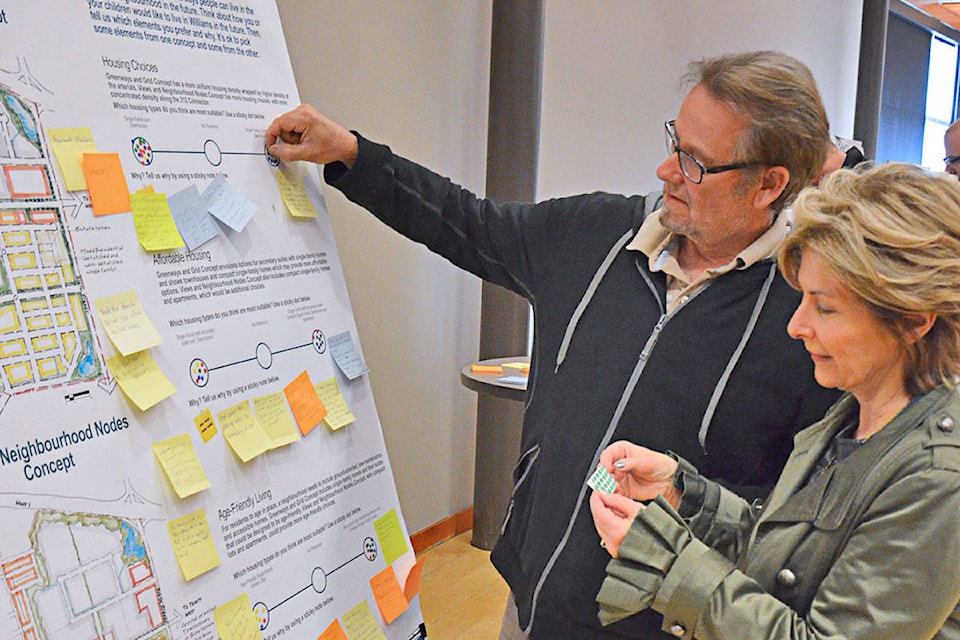Debates over commercial space and grocery stores didn’t stop the last neighbourhood plan in Willoughby from moving ahead to the next step at Langley Township council Monday.
The council debated the Williams Neighbourhood Plan, last of the 10 local plans guiding development in the fast-growing area.
Located between 212th Street and 216th, and from the Trans Canada Highway in the north down to 76th Avenue in the south, Willliams is expected to house about 4,600 people eventually.
At issue Monday was the amount of commercial space planned in Williams. A commercial node is planned for the area around 216th Street and 80th Avenue, including a grocery store and some office space.
“The general consensus is the rug’s going to be pulled out from underneath us,” said Hugh Carter, a vice president with Qualico who has been involved in the development of the Willoughby Town Centre at 208th Street south of 80th Avenue.
Carter said adding up to 19 acres of commercial and retail property in Williams, including a potential 34,000 square foot grocery store, would damage retail sales for Willoughby Town Centre by 15 to 20 per cent.
But Township staff, asked about the impacts, said their independent consultants showed that Langley residents are actually under served when it comes to commercial space.
About four square feet of retail space per resident is considered the right amount, said Ramin Seifi, head of community development for the Township. Even with the commercial space in Williams built out, Langley as a whole would only have three square feet of retail.
With the new 216th Street interchange being built, the Williams commercial zone is to serve residents of Walnut Grove to the north, which a staff report said is also under served for commercial space.
Willoughby’s population is already well above 30,000, but there is just one grocery store within the neighbourhood. Walnut Grove, with 24,800 residents, has two grocery stores.
Councillor Kim Richter proposed delaying a vote on the neighbourhood plan, to hear more extensively from Qualico and from would-be developers planning for the Williams area.
But a majority on council felt that there will be opportunities to hear from everyone at the next phase.
“The appropriate place at this stage is the public hearing,” said Mayor Jack Froese.
The Williams neighbourhood’s commercial sector is part of an “employment district,” with up to 3,500 people working in light industrial, manufacturing, and warehouses.
The plans presented to council include a residential area to the south, between 80th and 76th Avenue.
In the residential area, density has been changed from the original Willoughby Community Plan from 1998.
Plans for six-storey condos have been removed, and the bulk of homes are proposed to be townhouses, single-family lots, and some duplexes.
Most of the northern segment is the employment district, with the exception of a “transition district” running north-south and buffering the commercial and industrial area from the nearby single-family homes and townhouses of the Yorkson neighbourhood to the west.
The transition zone is to start with single family homes, then townhouses, and greenways. To boost parking, there will be laneways for the houses along with “enhanced off-street parking requirements,” according to the staff report.
A new elementary school site is planned for the area around 78th Avenue and 214th Street.
On the southernmost end of the neighbourhood, parks and greenways are planned to preserve some of the extensive treed areas around 78th Avenue.
One of the major influences on the Williams neighbourhood is the 216th Street highway interchange, now under construction and planned to open in the fall of 2019.
The plan presented to council has some amendments from earlier drafts, based on public feedback collected in 2016.
Having approved the first and second reading of the bylaws, the next phase is the public hearing, which is likely to be scheduled for April 23, according to Township staff.
